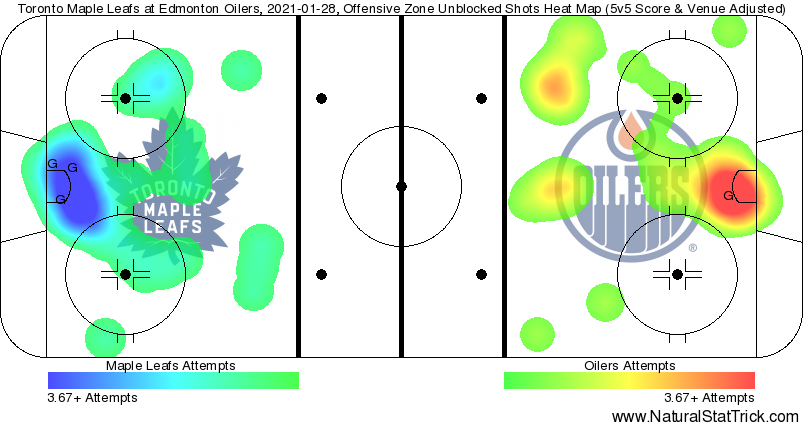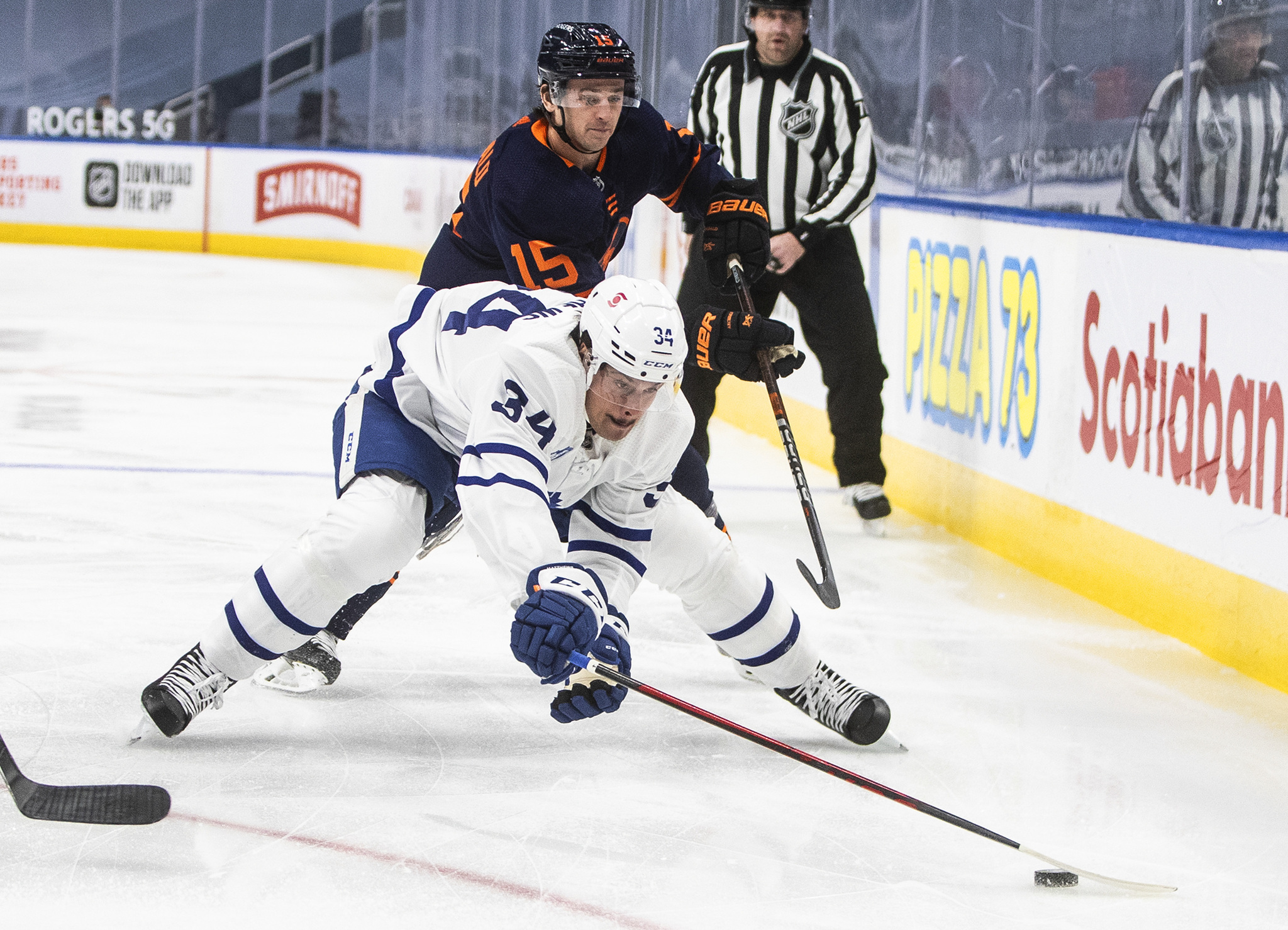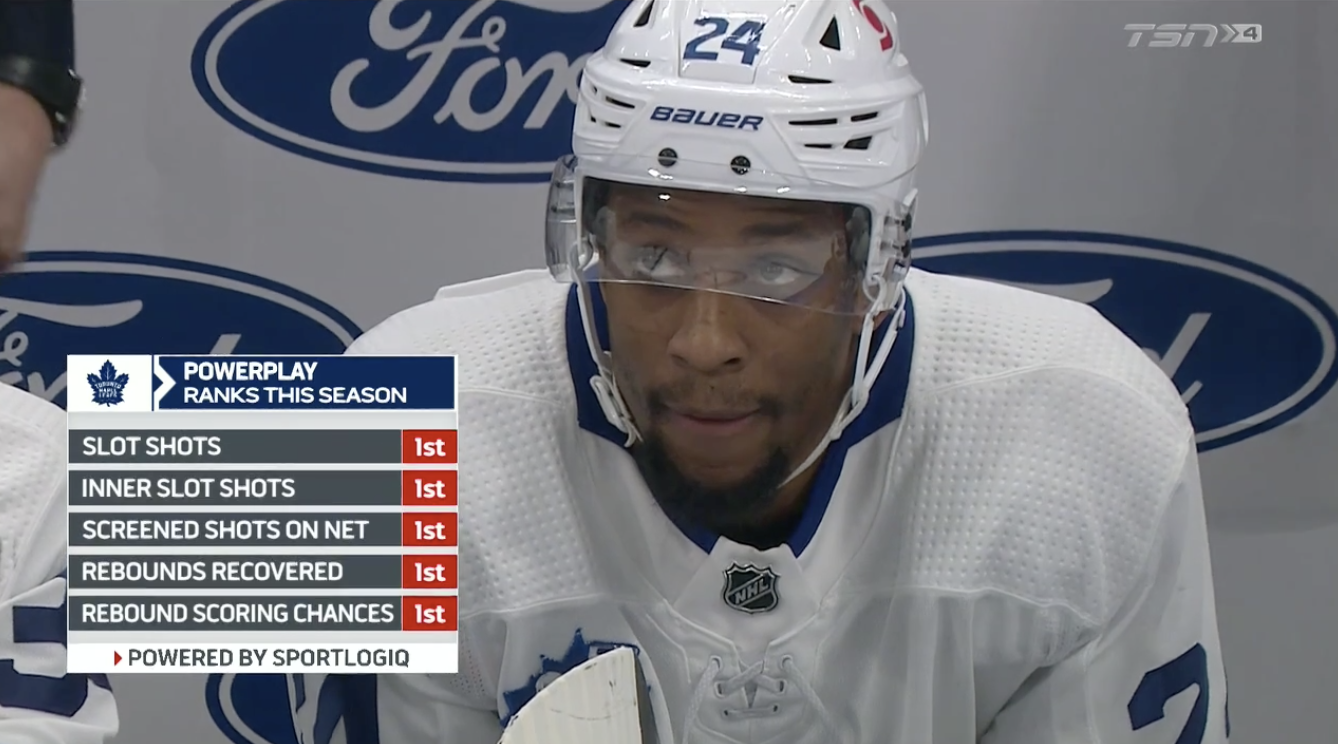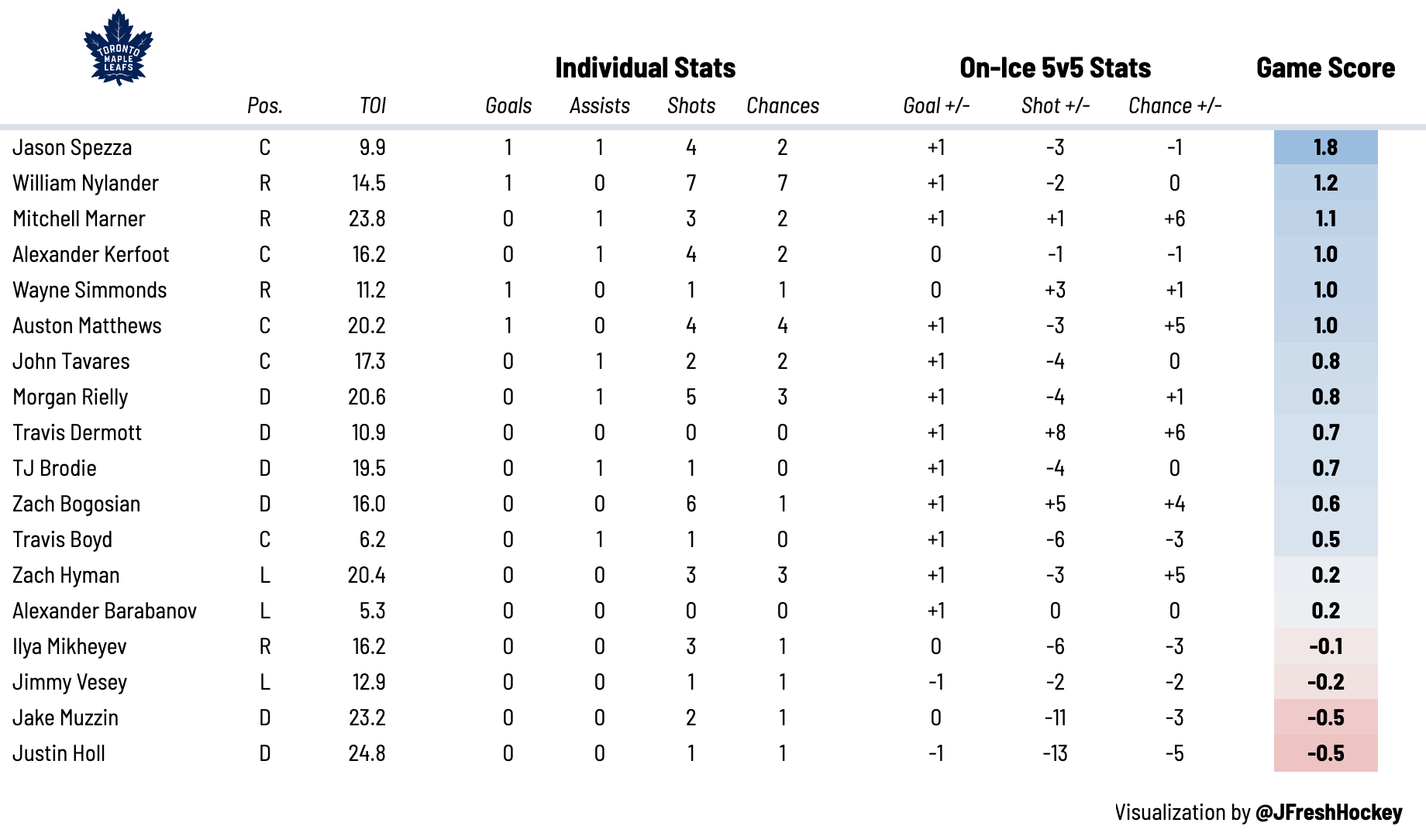Who says no one came to watch the refs?
In a game that was heavy on special teams, the Toronto Maple Leafs were able to hold on to a 4-3 win over the Edmonton Oilers. I’m not here to break down how many of those calls were “real” penalties — the short answer is not many — so let’s shift gears and focus on the individual player grades.
It’s time to hand out some report cards.
5/5 Stars
Game Puck: William Nylander (LW, #88) — It was clear from the quotes at the morning skate that everyone wanted Nylander to shoot more, including Nylander. He finished the game with a team-lead seven scoring chances, so I’d say mission accomplished in that department.
His shoot-first mentality was most obvious on the power play, where his teammates were looking to set up #88 for the one-timer on the left circle. Nylander got a few Grade-A chances from that spot, even hitting the post on one of his slap shots. His goal ended up coming from right in tight, which is where he scored most of his goals last season.
Jason Spezza (RW, #19) — After getting healthy scratched for a rest night on Tuesday, Spezza followed it up with his best offensive game of the season. His goal was a bit weird, coming off of a Mikko Koskinen turnover behind the net. It was Spezza’s play with the puck on his stick that really stood out to me tonight, especially on the power play. He did a great job threading cross-ice passes for one-timers, mostly to Nylander.
His best play of the game was a heads-up decision to stay on the ice at the end of the power play to keep the puck in, which led to a goal for Toronto.
Willy on the spot! #LeafsForever | #BellLetsTalk pic.twitter.com/RA4Ci8ud63
— Toronto Maple Leafs (@MapleLeafs) January 29, 2021
This looked much more like the Jason Spezza that we saw last season.
4/5 Stars
John Tavares (C, #91) — His hand-eye coordination still catches me off guard at times. If you watch that clip above again, you’ll see him bat the puck out of the air and then quickly chop a backdoor pass to Nylander before Edmonton’s PK has any time to react.
It’s what makes Tavares so effective in tight spaces, allowing him to stickhandle through traffic in the middle of the ice and quickly dish out passes to open teammates. This was most noticeable on the power play, although he did make a few similarly difficult plays at even strength.
Wayne Simmonds (RW, #24) — When I saw the Leafs put Simmonds on PP1 to start the year, I was concerned to say the least. Now that Toronto’s power play leads the NHL in all of the important shot and chance metrics, it might be time to admit Simmonds is still pretty good at this.
He scored his goal on a power-play deflection from the inner slot, which is what he’s paid to do. His time as a 5-on-5 driver has clearly passed, and he lost a battle on the wall before the Zack Kassian goal, but at 5-on-4, the numbers don’t lie. Simmonds is making an impact.
The Bottom Pair — Toronto’s third pairing looked noticeably more effective with Travis Dermott alongside Zach Bogosian rather than Mikko Lehtonen. Dermott was making crisp passes out of his own end, while Bogosian did his dirty work in the corners. I really liked the battle he got into with Kailer Yamamoto towards the end of the game behind the net, using his size advantage to pin the puck to the wall and kill off those extra precious seconds as the clock was winding down.
Frederik Andersen (G, #31) — Leon Draisaitl wouldn’t leave him alone in this game, but Andersen found a way to make some big stops down the stretch and help his team secure the victory. He’s starting to look much more fluid in his movements across his crease, reading the play well and getting himself square to the puck on those east-west passes.
3/5 Stars
The First Line — This was such a bizarre game. Auston Matthews didn’t accomplish much of anything for 53.5 minutes, then looked like he was shot out of a cannon after zipping one past Koskinen on the power play.
GEEEZ, @AM34 🔥#LeafsForever | #BellLetsTalk pic.twitter.com/3XENR7YqCo
— Toronto Maple Leafs (@MapleLeafs) January 29, 2021
His next two shifts afterward were his most dominant of the night, winning puck battles in his own end, leading the charge on the breakout, and wreaking havoc in the offensive zone.
Mitch Marner had another pretty quiet night at 5-on-5, but he had a huge impact on special teams. He spent over six minutes killing penalties and picked up an assist off of Simmonds’ stick on the power play.
Textbook tip 🙌#LeafsForever | #BellLetsTalk pic.twitter.com/pRatPbpZSH
— Toronto Maple Leafs (@MapleLeafs) January 29, 2021
Zach Hyman didn’t burn anyone off the rush in this game, but he did all those little Hyman things you expect him to in the top six.
The Rielly-Brodie Pair — At this point, we all know what Morgan Rielly is. He’s a rover; he likes to activate into the play with the puck on his stick and create offense. That’s not a problem when you have forwards covering for you, but the Leafs need to do a better job of recognizing when Rielly goes for a skate. There were far too many odd-man rushes when it was obvious #44 was jumping up in the play.
Both TJ Brodie and Rielly did a great job of using motion in the offensive zone to create passing lanes. It’s much harder to defend an OZ cycle when the players are all moving around rather than standing still. That said, it still feels as though the Matthews-Marner-Rielly-Brodie combination can get “stuck” on the perimeter at times instead of creating something more dangerous through the middle of the ice.
One final note: Brodie kept the puck in right before Matthews’ game-winning goal on the power play. I still don’t love Brodie quarterbacking PP2, but that was a great play.
Travis Boyd (C, #72) — He picked up an assist on that weird Spezza goal by stripping Koskinen of the puck. Boyd also made a few nice plays to get the puck going in the right direction at even strength. He’s only played two games in a Leafs uniform, but they’ve both been pretty solid. I’d say he’s earned himself another shot in the lineup.
2/5 Stars
Ilya Mikheyev (RW, #65) — One of these days a 2-on-1 pass is going to connect with Mikheyev, I just know it. He was an animal as usual on the penalty kill, but at 5-on-5, he wasn’t able to complement his skilled linemates much off the rush, which is the biggest concern with playing him so high in the lineup.
I love the defensive value Mikheyev brings, but if he isn’t able to create much offensively outside of those PK rushes, I do start to wonder where he fits best in this Leafs lineup.
Alexander Barabanov (LW, #94) — Another game, another five minutes of Barabanov not really accomplishing much of anything at even strength.
Jimmy Vesey (LW, #26) — The box score says he played 13 minutes, but I’m having trouble recalling one noteworthy play he made – offensively or defensively.
The Muzzin-Holl Pairing — Before you make your “Justin Holl is Nick Lidstrom when he plays Connor McDavid” joke, just keep in mind this pairing got hemmed in at even strength. That’s not entirely on Holl. His partner, Jake Muzzin, got walked by Darnell Nurse earlier in the game and was late to cover the man in front on both of Edmonton’s third-period goals.
These two were excellent on the penalty kill, but at 5-on-5, Holl in particular was failing to move the puck up the ice efficiently on the breakout. That’s an area where he usually thrives, so it’s probably nothing much to worry about in the long-term.
1/5 Stars
Alex Kerfoot (C, #15) — Let’s get this out of the way, his second “slashing” penalty was a nothing stick-on-stick play that shouldn’t have been called. The other two? Debatable, but Kerfoot has a reputation for taking ill-advised penalties, so I think we have to hold him somewhat accountable here. More importantly, Kerfoot had a few rough moments in transition that led to chances the other way. He also whiffed on a backdoor tap-in from Spezza late in the third period.
This just wasn’t his night.
Heat Map
Here’s a quick look at where each team’s shots were coming from at even strength, courtesy of Natural Stat Trick.
 The Leafs controlled 57 percent of the scoring chances at even strength despite only generating 49 percent of the total shots in this game.
The Leafs controlled 57 percent of the scoring chances at even strength despite only generating 49 percent of the total shots in this game.
Game Score
Game score is a metric developed by The Athletic’s Dom Luszczyszyn to measure single-game performance. You can read more about it here.



![Craig Berube on Morgan Rielly’s 2024-25 season: “He has been battling defensively, and I know the plus/minus doesn’t show it, but a lot of those are with the goalie out… Offensively, we’re going to need [more production] from him” Craig Berube, Toronto Maple Leafs head coach](https://mapleleafshotstove.com/wp-content/uploads/2025/01/berube-leafs-mtl-218x150.jpg)



























![Craig Berube on Morgan Rielly’s 2024-25 season: “He has been battling defensively, and I know the plus/minus doesn’t show it, but a lot of those are with the goalie out… Offensively, we’re going to need [more production] from him” Craig Berube, Toronto Maple Leafs head coach](https://mapleleafshotstove.com/wp-content/uploads/2025/01/berube-leafs-mtl-100x70.jpg)






